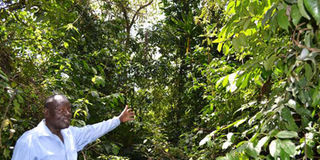Weatherman rainmakers team up to offer crop farmers accurate forecast

Amuchama Emitundo, one of the Nganyi rainmakers describes how trees and shrubs are used to predict weather. PHOTO | NATION MEDIA GROUP
What you need to know:
- The radio station named ‘Nganyi RANET Community Radio was set up by the Kenya Meteorological Department (KMD) in 2014 two years after a scientific research that proved the rainmakers have accurate and scientifically competitive weather information.
- The radio station disseminates the weather predictions from the rainmakers and advises farmers on crops to grow in relation to the rains.
- The findings of 2012 study attracted attention of the government, through the Meteorological Department, which now blends the traditional and modern weather predictions to give more accurate forecast to farmers
The scorching heat from the sun burns with vengeance in Bunyore, Vihiga County as residents go about their businesses.
Yet it is barely a month after the region, like the rest of the country, received heavy rains described as El Niño.
But despite the sharp divergence from the normal climatic conditions, residents of Bunyore knew the turn of events long before it stopped raining, thanks to the local rainmakers.
“It is not normal to receive so much rainfall especially in January and February. Through our community radio, the Nganyi (rainmakers) warned us against planting maize or other long season crops during the heavy rains season. Instead, I planted cowpeas and other indigenous vegetables like amaranth,” said Monica Namale, a farmer from Ess’ong’olo village.
The radio station named ‘Nganyi RANET Community Radio,’ but which residents have christened ‘Anyole Radio,’ because it broadcasts in Olunyole, the local dialect, was set up by the Kenya Meteorological Department (KMD) in 2014 two years after a scientific research that proved the rainmakers have accurate and scientifically competitive weather information.
Observing movement of birds to predict weather
The radio station disseminates the weather predictions from the rainmakers and advises farmers on crops to grow in relation to the rains.
Using a small forest shrine on a sloppy one acre extending to a stream, the descendants of the Nganyi community in Esibila village, Ebusiekwe sub location on the Kisumu – Busia Road have for generations observed behaviours of insects, animals, reptiles, trees (such as curling of leaves in the morning), migration patterns of bees, croaking sounds of frogs and songs of birds, among others, to provide accurate weather information for the day, a week and a month.
Farmers for years believed the rainmakers but authorities did not, with some people associating them with black magic.
However, following a research project known as Climate Change Adaptation in Africa under the UK’s Department for International Development and Canada’s International Development Research Centre (IDRC), scientists came across the shrine as they tried to link traditional and modern methods of adaptation to climate change.
The findings of their 2012 study attracted attention of the government, through the Meteorological Department, which now blends the traditional and modern weather predictions to give more accurate forecast to farmers.
“This was a very important revelation, therefore there was an urgent need to protect the forest shrine, and preserve the indigenous knowledge,” said Dr Gilbert Ouma, one of the lead researchers and a lecturer at the University of Nairobi’s Department of Meteorology.
Safeguarding community shrine
The Meteorological Department, with support from Intergovernmental Authority on Development, has constructed a resource centre near the shrine, where learners, researchers, tourists and interested individuals assemble and access information about the Abanyole people and their rainmaking activities.
As interests grow on the traditional knowledge of rainmaking, the research team has brought on board the Kenya Intellectual Property Institute and the National Museums to protect the shrines and ensure that community ownership of the knowledge on rainmaking is respected and protected.
“We discovered that these people have invaluable indigenous knowledge that has to be jealously protected,” said Dr Evans Kituyi, the Senior Programme Specialist for the Collaborative Adaptation Research Initiative in Africa and Asia Programme at the IDRC.
Boniface Omulako, one of the traditional weathermen from the Nganyi community, said the shrine has 67 known important plant species that include trees, shrubs and vines, and is home to different species of reptiles, birds and insects that help in weather forecasting.
“We have made it our daily duty to give weather information based on the integrated result from the indigenous rainmakers, and the weather station every one hour to enable people plan for their activities,” said Peter Mulwale, the CEO, Nganyi Ranet Community Radio Station.
The weather information has enabled local farmers adapt to the prevailing climatic changes.
“Without the forecasts, I would be panicking right now because the rains have not come as usual and I am planning to plant maize and beans. I already know that the dry spell will persist until the early weeks of April when proper rains will come. That is what the forecaster said the other week,” said Namale.





